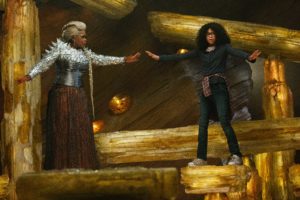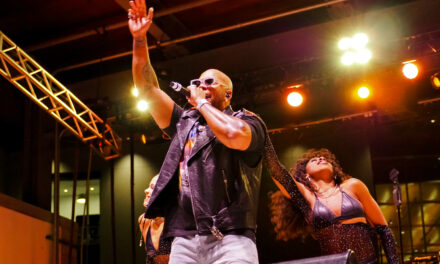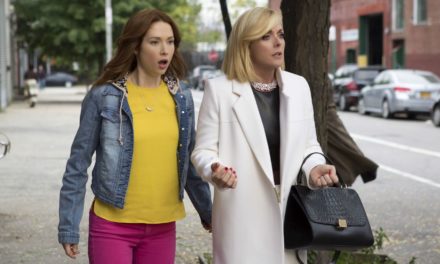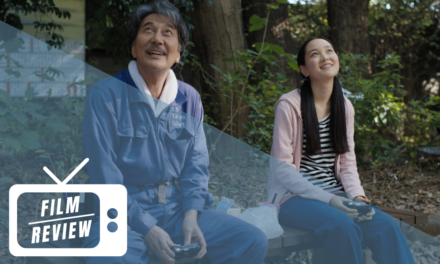In the midst of a cinematic moment where demands for representation and stories about bravery are increasing, Ava DuVernay’s, “A Wrinkle in Time” arrives on time, but intermittently struggles to assert itself. The film’s racially diverse cast and stunning visuals breathes new life into the 1962 Madeleine L’Engle novel on which it’s based. But the film fails to maintain a cohesive tone, undulating between macabre and playful. “A Wrinkle in Time”’s weaker elements are strengthened overall by the compelling performances of Chris Pine and the film’s young lead, Storm Reid. Its poignant social commentary on the importance of compassion provide an intriguing reimagining of the classic battle between light and dark.
The film tells the story of Meg, a clever young girl who embarks upon a rescue mission across the cosmos when her scientist father disappears. It begins with a long pan above the clouds that simulates flight. It is an appropriate and perhaps deliberate choice foreshadowing the imaginative narrative that follows. As we return to Earth, we are met with a scene of a young Meg Murry (Lyric Wilson) and her father, Dr. Alex Murry, (Chris Pine) conducting a science experiment in their home lab. Here we are introduced to Meg’s parents’ joint work with tesseracts — conduits that permit individuals to “wrinkle time” and travel light-years away in seconds. The remaining exposition consists of Dr. Alex Murry and Dr. Kate Murry (Gugu Mbatha-Raw) discussing the inclusion of their newly adopted infant son into the family and Meg’s father asserting that “love is always there even if you don’t feel it” — a sentiment that is elegantly woven throughout the film.
This opening scene introduces themes like empathy and the power of integrity. These ideas are enrapturing and contrast the darker elements of the film that follow it. The better moments of the film include a flying sequence where an older Meg (Storm Reid), her brother Charles Wallace (Deric McCabe) and her friend Calvin (Levi Miller) soar above a sea of flowers with the help of Mrs. Whatsit (Reese Witherspoon) and the penultimate scene in which Meg and the audience are forced to confront their greatest anxieties about loss. But the film lacks a tonal tether that makes the otherwise thoughtful dialogue and performances feel detached.
The unsettling mystery surrounding Dr. Murry’s tesser pools into the lives of each character and simulates the discomfort of Meg’s loss. This mixture of interpersonal isolation and the hope of eventual return is at times so dense that the film is difficult to watch. But Charles Wallace’s sagacious disposition and Calvin’s endearing boyishness both ease the Meg’s underlying bereavement.
Reid’s portrayal of Meg as a reverent family member and bereaved young girl are believable because they are delivered with deliberateness. This internal conflict is only emboldened by Meg’s racial identity. L’Engle didn’t write Meg’s character as a young black girl, but DuVernay’s infusion of the original character’s personal struggle with topical disquietudes that young women of color face adds depth to Meg’s struggle. Race operates within the film — as it does in real life — as an element of the overall experience, not the fulcrum of the experience itself. Thoughtful choices throughout the film address the nuance of race and gender. Calvin, Meg’s young, white male peer, intermittently compliments Meg’s curly natural hair and embraces her decision to lead the group. The Murrys are an interracial, renowned couple who together unravel the mystery of warp speed space travel. Furthermore, the light of the universe is personified through three women, two of whom are women of color. All of these choices powerfully communicate to the young audience how complex characters of all races and genders can be on and off screen. It also suggests that insurmountable heights may be reached if and when different people work together.
While “A Wrinkle in Time” is an enjoyable film with crucial ideas, there are moments where its banter and ephemeral beauty become crutches rather than integrated aspects of the story. That is likely a consequence of the central difficulty of making a good science fantasy film — making a protagonist’s journey to other worlds feel fantastic without being gimmicky or alienating the audience. The film yearns to characterize elsewhere in the universe through Oprah Winfrey’s otherworldly wisdom and Mrs. Which and Happy Medium (Zach Galifianakis) humor. But by doing so, the film lapses in its commitment to its central daunting idea, which makes those jokes feel compensatory. There are moments where I wanted the film to let us feel afraid and unsure, but instead it reassured us before we could acknowledge our own fear. “A Wrinkle in Time” is pleasant overall, with only certain residual moments and lines feeling out of place, but it is no masterpiece.
“A Wrinkle in Time” is an important film whose central message — that we should all be warriors of light when the darkness surrounds us — is uplifting. While the film struggles to juggle its playful, kid-friendly tone with its darker commentary, its striking aesthetic and dialogue on personal agency make it worth seeing.
Grade: B-
A&E Editor | adesola.thomas@emory.edu
Adesola Thomas (20C) is from Hampton, Ga., a place she refers to as "the land of cow pastures." She is a double major in political science and English. She enjoys cooking, long scenic walks and looking at pictures of black labs on the internet. The first song Adesola ever learned how to rap all the way through was Kanye West's "Herd Em' Say" which she now feels mildly conflicted about. Adesola brings up Greta Gerwig's "Lady Bird" at least once a day and wrote every one of her college admissions essays about the social impact of "Saturday Night Live." She can hide up to twelve pencils in her afro and enjoys writing about people and art.






